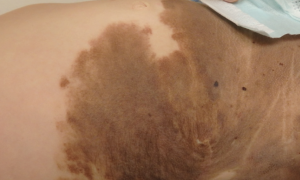Chapter 8: Lumps and Bumps
Melanocytic Lesions: Congenital Melanocytic Nevi
What is it?
Congenital melanocytic nevi (CMN) are present at birth although are sometimes first noticed later in the first year of life. CMN are classified by size according to their projected adult diameter. Small and medium CMN are significantly more common than large or giant.
Congenital melanocytic nevi classification:
Small: < 1.5cm
Medium: 1.5-20cm
Large: 20-40cm
Giant: >40cm
What does it look like?
CMN appear as light to dark brown papules or plaques that over time become thicker and develop dark, coarse hair within them. They may be speckled or have colour variation. Large and giant CMN can be associated with presence of smaller “satellite” nevi elsewhere on the body.
What are the possible complications?
The risk of melanoma in small and medium sized CMN is thought to be similar to the general population risk, and melanoma generally arises in adulthood. Large and giant CMN are thought to have an associated increased risk of melanoma, which is estimated at roughly 2-5%, and most often develops before the age of five. Many of these melanomas are deep or extracutaneous, such as in the CNS.
How is it treated?
The management of CMN is individualized for each patient. In any patient with a CMN a full cutaneous exam should be done to look for other nevi. Small and medium CMN do not need to be removed unless there is significant atypia. If they are of cosmetic concern, they can be excised. Patients with large and giant CMN should be referred for evaluation by dermatology, often in conjunction with plastic surgery, and need close follow-up. The decision to excise or debulk the lesion depends in individual factors. Children with multiple lesions are often referred for baseline MRI of the head due to the potential risk of CNS melanoma and neurocutaneous melanosis.


